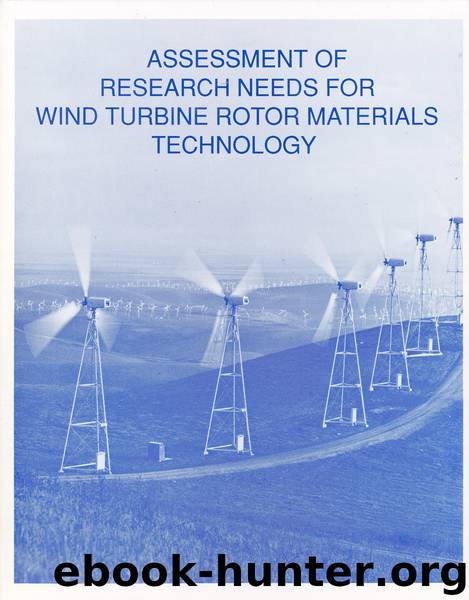Assessment of Research Needs for Wind Turbine Rotor Materials Technology by National Research Council (U.S.)

Author:National Research Council (U.S.).
Language: eng
Format: epub
Tags: Engineering and Technology : Materials. Engineering and Technology : Policy, Reviews and Evaluations
Publisher: National Academies Press
Published: 1990-12-31T16:00:00+00:00
Toughness Considerations
Wind turbine blades are expected to benefit from the use of tougher composites in several ways. One obvious benefit is the reduction in matrix cracking and hence a better protection of fibers from moisture degradation. Another benefit is the reduction in stress concentration and hence more efficient mechanical joining. In fact, one of the main causes for the hub failure in Aerostar blades is believed to be the crushing of the brittle polyester resin used. Last but not least, benefit is found in higher-impact resistance.
During their lifetime, wind turbine blades are subjected to impact by foreign objects such as rain drops, flying debris, and other objects. Since most impact occurs on the leading edge, proper protection of that leading edge can minimize the impact problems.
Composites are more susceptible to rain erosion than metals. Upon localized impact by rain drops, the matrix resin can be chipped away, exposing fibers. Impact by larger foreign objects can break the fibers, crack the matrix and interface, and induce delamination between plies. Impact damage may also occur during shipping and handling. Unfortunately, even an invisible damage caused by impact can substantially reduce compressive strength (Williams and Rhodes, 1981). Therefore, a low compressive strength after impact has been one of the main obstacles to wider application of composites.
Reduction of impact damage requires the use of tougher resins; yet, too tough a resin may inadvertently transfer too much load to the fibers during impact, resulting in unwanted fiber fracture. A compromise should be made between matrix/interface cracking and fiber break through proper selection of resin toughness. Nevertheless, a tough resin usually yields a higher compressive strength after impact than a brittle resin does.
As discussed earlier, much progress has been made lately in the development of toughened thermosetting resins for composites. As a result, there are a variety of toughened resins available at present. In addition, the high-performance thermoplastic resins in Table 3-4 all exhibit high toughness.
In general, a tougher resin yields a tougher composite. The relationship between the neat resin fracture energy and the composite interlaminar fracture energy appears to be bilinear (Hunston, 1987). When the resin is brittle, the composite has a higher interlaminar fracture energy than the resin fracture energy, mainly because of the fiber bridging. As the resin becomes tougher, however, not all the resin toughness is translated to the composite toughness. In fact, the composite fracture energy is only close to the rule-of-mixtures estimate.
There are other ways of improving the impact resistance of composite laminates. One method is to place a tough resin interleaf between plies to arrest ply cracks and to accommodate large, local shear stains induced by impact. The other is to provide reinforcements in the thickness direction by stitching (Hunston, 1990). These methods can be implemented without incurring too high a cost.
Glass fibers are more resistant to impact damage than carbon fibers. Thus, any scheme of composite toughening is expected to work better with glass fibers than with carbon fibers.
Download
This site does not store any files on its server. We only index and link to content provided by other sites. Please contact the content providers to delete copyright contents if any and email us, we'll remove relevant links or contents immediately.
| Automotive | Engineering |
| Transportation |
Whiskies Galore by Ian Buxton(41712)
Introduction to Aircraft Design (Cambridge Aerospace Series) by John P. Fielding(33011)
Small Unmanned Fixed-wing Aircraft Design by Andrew J. Keane Andras Sobester James P. Scanlan & András Sóbester & James P. Scanlan(32678)
Craft Beer for the Homebrewer by Michael Agnew(18076)
Turbulence by E. J. Noyes(7888)
The Complete Stick Figure Physics Tutorials by Allen Sarah(7258)
Kaplan MCAT General Chemistry Review by Kaplan(6814)
The Thirst by Nesbo Jo(6748)
Bad Blood by John Carreyrou(6468)
Modelling of Convective Heat and Mass Transfer in Rotating Flows by Igor V. Shevchuk(6349)
Learning SQL by Alan Beaulieu(6152)
Weapons of Math Destruction by Cathy O'Neil(6077)
Man-made Catastrophes and Risk Information Concealment by Dmitry Chernov & Didier Sornette(5870)
Digital Minimalism by Cal Newport;(5576)
Life 3.0: Being Human in the Age of Artificial Intelligence by Tegmark Max(5398)
iGen by Jean M. Twenge(5298)
Secrets of Antigravity Propulsion: Tesla, UFOs, and Classified Aerospace Technology by Ph.D. Paul A. Laviolette(5232)
Design of Trajectory Optimization Approach for Space Maneuver Vehicle Skip Entry Problems by Runqi Chai & Al Savvaris & Antonios Tsourdos & Senchun Chai(4949)
Electronic Devices & Circuits by Jacob Millman & Christos C. Halkias(4859)
